A sample text widget
Etiam pulvinar consectetur dolor sed malesuada. Ut convallis
euismod dolor nec pretium. Nunc ut tristique massa.
Nam sodales mi vitae dolor ullamcorper et vulputate enim accumsan.
Morbi orci magna, tincidunt vitae molestie nec, molestie at mi. Nulla nulla lorem,
suscipit in posuere in, interdum non magna.
|

People have been talking, and pontificating, about a coming “Internet of Things” since 1999. The idea is that the many sensors, actuators and digital data recorders in the environment around us — like the electronic control units (ECUs) in modern automobiles — will be uniquely identified and connected via IP to each other and to the world. This would allow instantaneous supply chain fulfillment, green initiatives like demand-side management and smart refrigerators, as well as simply cool stuff that puts remotely programming one’s DVR from a smartphone app to shame. As McKinsey & Co. noted in 2010:
The physical world itself is becoming a type of information system… When objects can both sense the environment and communicate, they become tools for understanding complexity and responding to it swiftly. What’s revolutionary in all this is that these physical information systems … work largely without human intervention.
So what’s going on? Two things. The obvious one is that more than a decade later (and despite the fact that by 2008 there were already more “things” connected to the Internet than people in the world) we are still not “there” yet. Refrigerators cannot detect when the last soda can is used, let alone order more autonomously; HVAC systems largely cannot interact with electricity genitors in real time to consume more energy when rates are lower, and vice-versa; and suitcases cannot communicate with airport luggage systems to tell the machines onto which flight they should be loaded (except with barcode readers). Partially, that’s because technologists frequently overstate adoption projections for new networks by 10 years or more. Less obvious is that there’s been a quiet push in the European Union (EU) to regulate the IoT even before it is fully gestated and born.
A European Commission “consultancy” on the Internet of Things was launched in 2008. By 2009 the EU had already issued an Action Plan for Europe for the IoT, which concluded:
Although IoT will help to address certain problems, it will usher in its own set of challenges, some directly affecting individuals. For example, some applications may be closely interlinked with critical infrastructures such as the power supply while others will handle information related to an individual’s whereabouts. Simply leaving the development of IoT to the private sector, and possibly to other world regions, is not a sensible option in view of the deep societal changes that IoT will bring about.
As a result, libertarian business groups such as the European-American Business Council and TechAmerica Europe have this summer come out in opposition to the EU’s approach, pressing for industry-led standards and application of existing measures, like the existing EU data protection rules (which already exceed the United States’ by a wide margin), “in lieu of a new regulatory structure.”
This is a scary prospect. That the EU would even consider crafting a regulatory scheme now for a technology revolution that realistically remains years away, requires immense levels of cooperation among industries, and holds the potential to transform business and life as we know it, is remarkable. Remarkable because such a philosophy is so alien to American economic values and to the spirit of innovation and entrepreneurship that launched the commercial Internet and Web 2.0 revolutions.
This article is not the place to debate the conflicts, trade-offs and differing views of government animating current technology policy issues like net neutrality, privacy and cybersecurity, copyright and the like. The reality though, is that issues such as those are generally being assessed within a spectrum of solutions, worldwide, which reflect known risks and benefits, some proposals of course being more interventionist than others. But that is far different from allowing a single bureaucratic monolith to dictate the shape of an industry and technology that remains embryonic. How is it even possible to develop fair rules for the IoT when no one has any real idea what or when it will be?
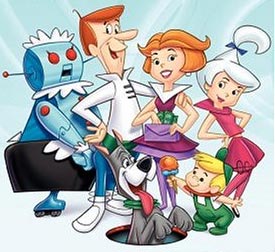 More than 15 years ago, this writer worked for one of his corporate clients on a legislative amendment offered by Rep. Anna Eshoo (D-Cal.) to the Telecommunications Act of 1996. The so-called “Eshoo Amendment,” designed to limit the role of the Federal Communications Commission in mandating standards for emerging, competitive digital technologies like home automation, passed. The irony, of course, is that at the time Congresswoman Eshoo analogized home automation to a future world like that of The Jetsons. Now 16 years down the road, we are barely closer to George, Elroy and their flying cars, robotic maids and the like than we were then. More than 15 years ago, this writer worked for one of his corporate clients on a legislative amendment offered by Rep. Anna Eshoo (D-Cal.) to the Telecommunications Act of 1996. The so-called “Eshoo Amendment,” designed to limit the role of the Federal Communications Commission in mandating standards for emerging, competitive digital technologies like home automation, passed. The irony, of course, is that at the time Congresswoman Eshoo analogized home automation to a future world like that of The Jetsons. Now 16 years down the road, we are barely closer to George, Elroy and their flying cars, robotic maids and the like than we were then.
But that ’96 effort illustrated a fundamental difference between the United States and the European Union about the proper role of government with respect to innovation. The EU subsidizes research, sets agendas and looks to intervene in the marketplace in order to establish rules of the road even before new industries are launched. The US sits back, lets the private sector innovate, and generally intervenes only when there has been a “market failure.” That’s a philosophy largely embraced by both major American parties regardless of the increasingly polarized political landscape in Washington, DC.
This basic difference in world views between the home of the Internet and European regulators — as true today as in 1996, if not more so — could doom the Internet of Things. So if you are a fan of future shock, then it’s clear you should not react to the EU’s efforts to shape the IoT with a viva la difference attitude. The difference is dangerous to innovation and especially dangerous to disruptive innovation. It’s no wonder that few real digital innovations have come from Europe. Don’t expect many in the future unless the EU finds a way to decentralize and privatize its bureaucratic tendency towards aggrandizing government in the face of what IoT experts anticipate will be “a small avalanche of disruptive innovations.”
Note: Originally prepared for and reposted with permission of the Disruptive Competition Project.
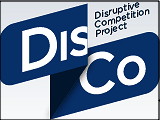

For all the discussion, dead-on accurate, about law holding back technological innovation, sometimes it works the other way around. When industries are transformed by disruptive new technologies and business models, the law itself can be in for a game-changing, forced makeover.
Take the European Union (EU) and digital music. Everyone by now realizes that the introduction of portable MP3 music players, coupled with Apple’s pioneering iPods and iTunes music store, have revolutionized the market for distribution of recorded music. Gone are the days of buying albums (or even CDs) just to get one hit song. Music is available on any device, in the cloud, streaming on desktops, and everywhere else, and it’s intensely personal playlists involved. As a result, the hockey stick adoption curve shows that hardly a decade after digital music downloads first gained popularity, “record stores” – Tower Records,
anyone? – are a thing of the past, record labels (EMI as the latest) appear to be on their last hurrahs, and fully 1/2 of all music
purchased in the United States is totally digital, never burned to a physical product.
 That has not been the case in the EU. Despite a standard of living in excess of the US, less than 20% of music sold in Europe is digital. That’s in part because, under the EU Treaty, copyright licensing is conducted on a member state basis. This “balkanization” of the law (pun intended) means that digital sellers in the EU need to negotiate separate deals with each label and for each country, from France to the Czech Republic to Turkey, under very different legal regimes. That’s obviously a recipe for increasing costs and timeframes for entry, bad for business and keeping new distribution models from consumers. That has not been the case in the EU. Despite a standard of living in excess of the US, less than 20% of music sold in Europe is digital. That’s in part because, under the EU Treaty, copyright licensing is conducted on a member state basis. This “balkanization” of the law (pun intended) means that digital sellers in the EU need to negotiate separate deals with each label and for each country, from France to the Czech Republic to Turkey, under very different legal regimes. That’s obviously a recipe for increasing costs and timeframes for entry, bad for business and keeping new distribution models from consumers.
In response, the EU Commission used its competition powers a couple of years ago to harmonize copyright laws in order to make them consistent throughout the EU, aimed at breaking down national barriers in the digital music business and making it possible for rights holders to issue pan-European licenses. As one can observe from a similar step towards telecom “liberalisation” in the ‘00s, however, that itself requires a vigilant enforcer at the EU level to ensure that parochial national legislatures and courts do not slow roll the process. This 2008 licensing change helped Apple launch its iTunes music store in all 27 European nations, but so far no one else. In 2009, major members of the online music industry — including
Amazon, iTunes, EMI, Nokia, PRS for Music, Universal, and others — signed a pact with the European Commission to work towards wider music distribution in Europe.
Yet Apple remains the only digital music seller with licenses to operate in every EU country. And even then, Apple rolled out iTunes stores in Poland, Hungary and 10 other European countries just last year, seven full years after arriving in Germany, the UK and France. As ArsTechnica comments:
Unlike the US, online music in Europe is typically only sold through one country’s stores at a time — this is despite the EU’s efforts to effectively eliminate the borders of its 27-country membership when it comes to products and services. As such, if you’re in Spain and want to buy a song from France’s iTunes store, you can’t — the store blocks you from making the purchase because you aren’t in France. This has led to companies like Apple rolling out individual music stores for each European country with a large enough market, but the fragmentation has caused nothing but headaches for end users who just want to listen to their favorite music.
Finally—One iTunes Store to Rule Them All (in Europe).
The reality is therefore that the “single market” for intellectual property rights (IPR) contemplated in the EU’s 2011 report is far from ready to roll. As Neelie Kroes, who once took on Microsoft and now serves as the EU’s Vice President, asked rhetorically in ’08, “Why is it possible to buy a CD from an online retailer and have it shipped to anywhere in Europe, but it is not possible to buy the same music, by the same artist, as an electronic download with similar ease?”
So this week the EU is going a step further. Singling out “collecting societies” – European analogs to ASCAP and BMI which gather royalties of about €6 billion, or $7.5 billion, annually from radio stations, restaurants, bars and other music users and distribute the proceeds to authors, composers and other rights holders – the EU plans to push towards a directive requiring greater efficiency, transparency and reciprocity. Royalty-collection societies could be forced under the draft rules to transfer their revenue-gathering activities to rivals if they lack the technical capacity to license music to Internet services in multiple countries. The idea seems to be that if it cannot reduce the sheer number (some 250) of collecting societies, at least the European Commission can make sure they operate as much in unison as possible.
A lesson to be drawn from this ongoing saga is that just as technical innovation can disintermediate industries and eliminate arbitrage as an economic profit motive among different markets, so too can it work to force elimination of legal differences among jurisdictions. Especially where the medium is the Internet, inherently global and regulated by no one (unless the European-centric International Telecommunications Union has its way), these legal changes can occur very quickly. Believe it or not, the four years over which the EU has been working for digital copyright licensing harmonization is lightning pace for the law.
Note: Originally prepared for and reposted with permission of the Disruptive Competition Project.

Comedy Central’s South Park has opened the door for “fair use” copyright defenses to shut down infringement lawsuits before they saddle defendants with discovery expenses or force a settlement for cost reasons.
The U.S. Court of Appeals for the 7th Circuit in Chicago ruled just weeks ago that the cartoon’s parody of a popular Internet video — if you watch South Park, you know which one — was a protected parody. The episode “Canada on Strike” lampoons the juxtaposition of viral videos’ popularity with their typically paltry financial returns through advertising and licensing. Brownmark Films, which owns the copyright on the original video, sued Comedy Central and network owner Viacom for infringement. (Incidentally, both music videos were posted on You Tube, the same company that Viacom had sued for a billion dollars in March 2007 for alleged copyright infringement.) The appeals panel unanimously agreed that the South Park video was “obvious” fair use, “providing commentary on the ridiculousness of the original video and the viral nature of certain YouTube videos,” and upheld the suit’s dismissal.
Fair use under copyright law occurs when an earlier work is used by a latter work for commentary, parody, education or some other purpose whose main goal is not to secure financial gain. Recognizing the essential nature of South Park as a mature, adult-oriented animated series, the 7th Circuit emphasized that “[t]he show centers on the adventures of foul-mouthed fourth graders in the small town of South Park, Colorado. It is notorious for its distinct animation style and scatological humor [and] frequently provides commentary on current events and pop-culture through parody and satire.” Yet without getting into all the procedural wrinkles, the court also broke new legal ground in its discussion of the role of early dismissal of “weak claims” and disposition based on a fair use claim alone, in fighting against the “chilling effects” of First Amendment-related litigation.
Despite Brownmark’s assertions to the contrary, the only two pieces of evidence needed to decide the question of fair use in this case are the original version of [the viral video at issue] and the [South Park] episode at issue… We think it makes eminently good sense to extend the [incorporate by reference] doctrine to cover such works, especially in light of technological changes that have occasioned widespread production of audio-visual works. The expense of discovery … looms over this suit. Ruinous discovery heightens the incentive to settle rather than defend these frivolous suits. [Thus,] district courts need not, and indeed ought not, allow discovery when it is clear that the case turns on facts already in evidence.
An unusually frank and colorful opinion by long-time Circuit Judge Richard Cudahy (first appointed by President Jimmy Carter in 1979) provides some comedy itself. Brownmark could have offered its own evidence to defeat the fair use defense but chose not to, Cudahy wrote. Its “broad” discovery request made Brownmark look like a “copyright troll” and would allow “expensive e-discovery of emails or other internal communications.” Brownmark’s only plausible copyright claim could be be that the parody harmed the market for its original video, but “as the South Park episode aptly points out, there is no ‘Internet money’ for the video itself on YouTube, only advertising dollars that correlate with the number of views the video has had.” Cudahy concluded “[i]t seems to this court that” the parody video’s “likely effect, ironically, would only increase ad revenue.”
Sometimes the courts actually do get it when technology is involved, although we have no idea whether Judge Cudahy himself watches South Park. As the Electronic Frontier Foundation, which submitted an amicus brief on behalf of Comedy Central, explained:
The opinion joins a growing body of precedent affirming that it’s proper to dismiss some copyright cases early, and that it’s possible in appropriate cases to determine whether a use is noninfringing without engaging in lengthy discovery. These rulings are important not only to protect speech, but also in fighting back against copyright trolls. Trolls depend on the threat of legal costs to encourage people to settle cases even though they might have legitimate defenses.
Of course, “trolls” are in the eye of the beholder. Like terrorists, one person’s troll may be another’s “freedom fighter.” So whether or not particular litigants merit that somewhat pejorative description, it’s clear that the costs and burdens associated with defending copyright claims — including but not only for Internet-distributed video — just went down a whole lot. While Brownmark involved a seemingly easy fair use case in the defendants’ favor, it will be interesting to see whether future courts will grant motions to dismiss where the fair use analysis is less obvious. In any event, copyright infringement plaintiffs should be aware that the road to discovery where a defendant raises a fair use defense is not be quite as smooth as it used to be.
As to judicial comedy, we express no opinion, but do like the district judge’s tact. “For as remarkable and fascinating the parties and issues surrounding this litigation are, this order, which will resolve a pending motion to dismiss will be, by comparison, frankly quite dry.”
The legal issues [in this case] are hardly the sort of subject that would create millions of fans, as the work of all of the parties before the court did. Nonetheless, while the court has a ‘tough job,’ ‘someone has to do it,’ and, ‘with shoulder to the wheel,’ this court ‘forge[s] on’ to resolve the pending motion. Janky v. Lake County Convention & Visitors Bureau, 576 F.3d 356, 358 (7th Cir. 2009).
Note: Originally written for and reposted with permission of my law firm’s Information Intersection blog.


One year ago, the Wall Street Journal and other business publications reported that the Federal Trade Commission (FTC) had launched an investigation into “Twitter and the way it deals with the companies building applications and services for its platform.” The gist of the apparent competitive concern was that Twitter — which has grown from nothing to a significant new medium of social communications in just five years — had decided to limit access to its application programming interfaces (APIs) for third-parties, such as HootSuite, Echofon and the like, selling Twitter “client” software.
There’s no doubt Twitter is a disruptive technology. Of course, in 2000 the FTC was so convinced that an AOL-Time Warner combination would monopolize Internet content that it saddled the then-biggest merger with an onerous consent decree that evaporated, as did AOL itself, in the relative blink of an eye. Now it appears the agency is making the same mistake again. Assuming that a new and evolving technology represents a stand-alone market for antitrust purpose is dangerous where disruptive entrants are concerned, because as AOL illustrates, despite a first-mover advantage, even in network effects markets that may “tip” to a single firm competitive reality changes more quickly and in ways even the brightest pundits and government policy makers could never predict.
 Given that Twitter is in competition with Facebook, LinkedIn, Tumblr, Pinterest, Instgram and many other social networking and messaging services, including the near-moribund Google+, you’ve got to wonder why the FTC could even plausibly hypothesize that Twitter has anything approaching monopoly power. One can perhaps understand policy neophytes like Mike Arrington naively saying that Twitter has a “microblogging monopoly,” but not seasoned antitrusters. Given that Twitter is in competition with Facebook, LinkedIn, Tumblr, Pinterest, Instgram and many other social networking and messaging services, including the near-moribund Google+, you’ve got to wonder why the FTC could even plausibly hypothesize that Twitter has anything approaching monopoly power. One can perhaps understand policy neophytes like Mike Arrington naively saying that Twitter has a “microblogging monopoly,” but not seasoned antitrusters.
Twitter management explained at the time that “Twitter is a network, and its network effects are driven by users seeing and contributing to the network’s conversations. We need to ensure users can interact with Twitter the same way everywhere.” That’s a quintessential business judgment by corporate managers who presumably know their users (tweeters) and customers (advertisers) best. The company’s motivation is also clear and perfectly valid: it doesn’t want third parties making money — namely, coming into direct rivalry by selling ads — off its service, and thus depriving Twitter of potential revenue. It is incontestable that Twitter could vertically integrate into the client software business itself (a first step in which it did by acquiring TweetDeck), without any possible antitrust constraints. In this light, what could conceivably be wrong with Twitter setting ground rules that require third-party providers to utilize a common user interface (UI) scheme?
As Adam Thierer of the Technology Liberation front observed in 2011:
This episode again reflects the short-term, static snapshot thinking we all too often see at work in debates over media and technology policy. That is, many cyber-worrywarts are prone to taking snapshots of market activity and suggesting that temporary patterns are permanent disasters requiring immediate correction. Of course, a more dynamic view of progress and competition holds that “market failures” and “code failures” are ultimately better addressed by voluntary, spontaneous, bottom-up responses than by coercive, top-down approaches
Ironically, the Twitter decision to control API usage and effectively boot off some third-party software had only one economic effect. It cannibalized Twitter’s own developer and partner ecosystem, on which the company had relied heavily through its first years of extraordinarily rapid growth, in favor of an internal solution. That decision alienated some Twitter users and almost certainly reduced the absolute number of tweets sent and received — and thus the page views on which Twitter’s advertising rates are necessarily based. It also risked alienating the venture capitalists who have invested an estimated $475 million over just one-half of a year in companies working to develop Twitter-compatible apps and utilities. So the only firm Twitter is really hurting by this practice is Twitter itself. Eating your own ecosystem is hardly the stuff of monopolization.
Sacrificing independent distribution in favor of vertical integration is also a business model companies adopt and reject like roller coasters. In the oil industry, for instance, the most famous government antitrust case of them all is 1911’s Standard Oil, which broke up the vertically integrated petroleum monopoly assembled by John D. Rockefeller. Today, Standard’s offspring are rapidly disintegrating, divesting both wholesale distribution of refined oil products and retail gasoline dealerships. Sometimes conventional business wisdom extols vertical integration, other times it emphasizes an Adam Smith-type comparative advantage. But isn’t that the essence of marketplace competition? And in turn isn’t that something our nation’s competition policy should leave in the hands of market participants rather than government agencies?
The answer from Forbes is a simple yes:
If the FTC is indeed investigating Twitter, they are likely to find this case pretty boring. In acquiring the third party apps widely adopted by its users, Twitter is simply making a gradual, not to mention inevitable, move closer to its customer base. The startup is often slammed for its struggle to adopt a serious business model. Now that Twitter has finally figured out it is awfully difficult to build a business as a plumbing conduit, suddenly it’s lambasted as the next Microsoft.
In fact, the issue here is far more significant for technologies down the road that no one has as yet even conceived. Twitter seems sufficiently well-established that it will likely survive an FTC investigation, at least in the short run, and however misguided the government’s underlying assumptions may be. But start-ups which have not yet escaped from private betas and coders’ college dorm rooms will give pause, as they grow, before deciding to sever relations with partners 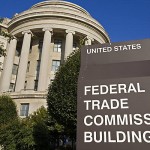 that helped them “get big fast.” The fear is that cutting off downstream firms, even if taken for objectively valid business reasons, will catalyze an FTC or European Union antitrust investigation of whether the firm has “abused” its “market dominance.” that helped them “get big fast.” The fear is that cutting off downstream firms, even if taken for objectively valid business reasons, will catalyze an FTC or European Union antitrust investigation of whether the firm has “abused” its “market dominance.”
A threat of government action can be just as debilitating to innovation as premature enforcement intervention into the marketplace. Let’s hope the FTC’s 2011 Twitter investigation is mothballed in 2012, and that in the future investigations of segment-leaders in nascent technology spaces are opened only where — unlike the case of Twitter — there’s clearly an economically valid market and practices involved which are unambiguously anticompetitive. The FTC has said nothing about the Twitter issue for a year, while the San Francisco Examiner revealingly comments that “[i]n the space of [that] year, the FTC has racked up more legal action involving the high tech world than the FCC and both houses of Congress combined.” Note to Chairman Leibowitz: it’s time to let this one go, now. If your agency wants to do that quietly in order to save face, no one in Silicon Valley will mind at all. We won’t tell.
Note: Originally prepared for and reposted with permission of the Disruptive Competition Project.

At the DisCo Project, we naturally focus on the current, dynamic technology marketplace and the disruption it is continuing to cause to brick-and-mortar and other “legacy” industries. But disruptive innovation is not new and not unique to high-tech. It’s been around for hundreds of years and serves as a key driver of both economic growth and social evolution.
Let’s start with the poster child of disruption, buggy whip manufacturers. In the late 19th century there were some 13,000 companies involved in the horse-drawn carriage (buggy) industry. Most failed to recognize that the era of raw horsepower was giving way to that of internal combustion engines and the automobile. Buggy whips, once a proud, artisan craft, essentially became relegated to S&M purveyors. Read Theodore Levitt’s influential 1960 book Marketing Myopia for a more detailed look.
Not everyone was obsoleted by Henry Ford. Timken & Co., which had developed roller bearings for buggies to smooth the ride of wooden wheels, prospered into the industrial age by making the transition to a market characterized as “personal transportation” rather than buggies.  Likewise carriage interior manufacturers, who successfully supplied customized leather-clad seats and accessories to Detroit. Likewise carriage interior manufacturers, who successfully supplied customized leather-clad seats and accessories to Detroit.
One might suspect this industrial myopia has been confined to small markets with few dominant players. But not hardly. One of the more famous series of patent cases in history were the battles between Western Union and Alexander Graham Bell in the 1870s, where the telegraph giant (along with scores of others) vainly tried to contest Bell’s U.S. patents on the telephone. Ironically, the telephone was initially rejected by Western Union, the leading telecommunications company of the 1800s, because it could carry a signal only three miles. The Bell telephone therefore took root as a local communications service simple enough to be used by everyday people. Little by little, the telephone’s range improved until it supplanted Western Union and its telegraph operators altogether.
Apart from scurrilous character assassination suggesting Bell had bribed U.S. Patent and Trademark Office clerks to stamp his patent application first, the telephone patent cases are best remembered for their eventual 1879 settlement. Western Union assigned all telephone rights to the nascent Bell System with the caveat that Bell would not compete in the lucrative telegraphy market. After all, Western Union surmised, no one wanted to have their peaceful homes invaded by ringing monsters from the stressful outside world. Check out this verbatim 1876 internal memo from Western Union:
Messrs. Hubbard and Bell want to install one of their “telephone devices” in every city. The idea is idiotic on the face of it. Furthermore, why would any person want to use this ungainly and impractical device when he can send a messenger to the telegraph office and have a clear written message sent to any large city in the United States?
Epically wrong! But that, of course, is the challenge of disruptive innovation. It forces market participants to rethink their premises and reimagine the business they are in. Those who get it wrong will be lost in the dustbin (or buggy whip rack) of history. Those who get it right typically enjoy a window of success until the next inflection point arrives. Were barbers out of business when, some 200 years ago, doctors began to curtail the practice of bleeding patients, eventually usurping barbers as providers of health care? No, because barbershops moved from medicine to personal grooming.
Disruptive technologies create major new growth in the industries they penetrate — even when they cause traditionally entrenched firms to fail — by allowing less-skilled and less-affluent people to do things previously done only by expensive specialists in centralized, inconvenient locations. In effect, they offer consumers products and services that are cheaper, better, and more convenient than ever before. Disruption, a core microeconomic driver of macroeconomic growth, has played a fundamental role as the American economy has become more efficient and productive.
Clayton Christensen, Thomas Craig and Stuart Hart, The Great Disruption
There are hundreds or thousands more examples we can discuss. Polaroid and Kodak, both innovators in their own right, have faced bankruptcy and virtual irrelevance over the past few years because they could not cope with rapid disintermediation of their photography businesses by digital technologies. Walgreens, CVS and camera shops, meanwhile, have retained a solid photography revenue stream by supporting photo printing from SD cards and even Facebook photo collections.
Some businesses get it and some do not. Disruptive competition drives out those whose world view tries quixotically to preserve the past or to protect economic and social customs from technology-driven change. Disruption is of course not a panacea for all social ills; New Yorkers, for instance, complained as much about the filth and stench of cobblestoned city streets filled with horse droppings in the 19th century as they did about the filth and stench of paved streets filled with cars and CO2 fumes in the 20th century. As an economic and competitive matter, however, disruption is a process of continually “out with the old and in with the new.” And it’s been that way for as long as anyone can remember.
Courtesy of Disco Project | Of Buggy Whips, Telephones and Disruption.
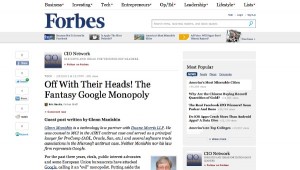
Today Forbes published an op-ed article I wrote on the antitrust furor surrounding Google. Here’s the concluding paragraph:
Google doesn’t act like a monopolist and shares none of the characteristics sheltering classic monopolists from competition. Its astounding success in Internet search is universally regarded as a consequence of better design, superior code, better products and plain old hard work. Like Lewis Carroll’s other queen, the Queen of Hearts, Google really has no power at all. Just as the Alice in Wonderland queen could majestically dictate “off with their heads” with absolutely no effect, Google must continue to run faster simply to stay in the same place. That’s not a monopoly; instead it is a success story that should be applauded.
Off With Their Heads! The Fantasy Google Monopoly | Forbes.
With reality television all the rage, viewers may wonder why there’s been no reality series about the inbred high-tech ecosystem of Silicon Valley. There should be, because the reality of how our technology bastion really competes today — namely by patent litigation and acquisitions — is astonishing.
Last year Google, Apple, Intel and other leading Silicon Valley companies were targeted by federal antitrust enforcers for tacitly agreeing not to hire each other’s key employees. Such a conspiracy could have landed top executives in jail. This year Apple, Samsung, Google, Nokia and others have all been battling over back-and-forth claims that smartphones and wireless tablets infringe each others’ U.S. patents. Now, just weeks after Google’s general counsel objected that patents are gumming up innovation, the search behemoth has announced its own $12.6 billion acquisition of Motorola Mobility, and with it their own portfolio of wireless patents, just a fortnight after purchasing a relatively few (“only” 1,000 or so ) wireless patents from IBM.

While the executives at Google have nothing to fear personally from these patent wars, others seem to have a lot at risk. That is because, according to the Wall Street Journal, the U.S. Justice Department’s Antitrust Division is investigating another possible conspiracy among Silicon Valley companies. This one arises out of the collective bid in the late spring of nearly every wireless phone operating system manufacturer, except Google, for a portfolio of 6,000 cell phone patents formerly held by bankrupt Canadian company Nortel. Simply put, Google started the bidding at about $1 billion, but the others joined forces to lift the price to an astounding $4.5 billion and win the prize.
That’s the legal background to Google’s just-announced Motorola Mobility acquisition, and it’s one that could have serious anticompetitive consequences. If the curiously named “Rockstar Bidco” consortium — which includes Microsoft, Apple, RIM, EMC, Ericsson and Sony — refuses to license the erstwhile Nortel patents to Google for its Android wireless operating system, they will be agreeing as “horizontal” competitors not to deal with a rival. Classically such group boycotts are treated as a serious antitrust no-no, and a criminal offense. If the group licenses the patents, on the other hand, they could be guilty of price fixing (also a possible criminal offense), since a common royalty price was not essential to the joint bid and would eliminate competition among the members for licensing fees.
If the Rockstar Bidco companies decide to enforce the patents by bringing infringement litigation against Google, things could be even worse. Patent suits themselves, unless totally bogus, are usually protected from antitrust liability so as not to deter legitimate protection of intellectual property assets. (That does not mean they’re competitively good, since patent suits are often just a means of keeping rivals out of the marketplace.) Nonetheless, a multi-plaintiff lawsuit by common owners of patents would have those same horizontal competitors agreeing on lots of joint conduct, well beyond mere license rates. For starters, is the objective of such an initiative to kill Android by impeding its market share expansion? That’s a valid competitive strategy, standing alone, for any one company; it takes on a totally different dimension when firms collectively controlling a dominant share of the market gang up on one specific rival.
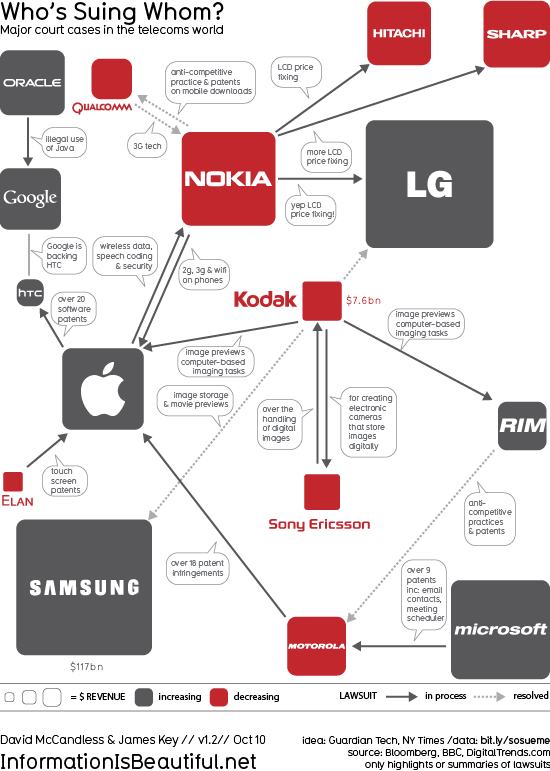
Google’s broader complaint that patent litigation in the United States is too expensive, too uncertain and too long may well be right. This bigger issue is being debated in Washington, DC as part of what insiders call “patent reform.” The high-stakes competitive battles being waged today in the wireless space under the guise of esoteric patent law issues like “anticipation” by “prior art” suggest a thoroughly Machiavellian approach to the legal process, just as war is merely diplomacy by other means. They inevitably color the perspective of policy makers, who watch with regret as a system designed to foster innovation gets progressively buried with expensive suits, devious procedural maneuvering and legalized judicial blackmail.
Even the biggest companies, though, would find it hard to compete if their largest rivals were allowed to form a members-only club around essential technologies to which only they had access. Microsoft’s own general counsel countered two weeks ago that Google was invited to join an earlier consortium bid but declined before the Nortel auction. Embarrassing, yes; dispositive, no. If the offer were still open, now that it is clear Google’s principal wireless rivals are all members, things would be different. Indeed, there’s even an opposite problem of antitrust over-inclusiveness where patents and patent pools are concerned. If everyone in an industry shares joint ownership of the same basic inventions, where’s the innovation competition? Google’s defensive purchase of Motorola is a desperate, catch-up move that does not really change this “everyone-but-Android” reality.
Silicon Valley’s patent wars are for good reason not nearly as popular as Bridezillas or So You Think You Can Dance. Yet they are far more important, economically, to Americans addicted today to their smartphones and spending hundreds of dollars monthly on wireless apps and services. Whether the Justice Department will challenge the Rockstar Bidco consortium or give it a free pass remains to be seen. From a legal perspective, it is just a shame the subject is too arcane, and certainly way too dull, to make a reality TV series.
If you’re read my The Law of Social Media essays or presentations, you probably know there have been few serious cases yet establishing law specifically targeting social media. One can apply basic principles to predict what courts will do, but so far there are only a handful of reported decisions that say anything at all about social media.

That does not mean nothing happened in 2010 in this rapidly evolving area. In my view, the most important developments are reflected in these four cases:
1. The Food & Drug Administration’s citation of Novartis for Facebook content that lacked required pharmaceutical side-effect warnings and disclaimers, and the agency’s subsequent delay in release of social media “guidance” for pharma until Q1 2011. The case illustrates that heavily regulated industries face special risks and burdens in structuring social media marketing campaigns.
2. The assertion of jurisdiction by the National Labor Relations Board over “protected activity” of employees (discussing working conditions, for instance) on Facebook, even where the company is not unionized. This shows that, although equal employment issues still dominate employers’ use of social media in hiring and firing, there may be limits to which companies can penalize workers for their social media posts if the content is work-related.
3. The New Jersey Supreme Court’s decision in in Stengart v. Loving Care Agency, Inc., reversing the older, black-letter rule that employees have no privacy interests at all in employer-provided email systems.
4. The decision just days ago by the U.S. Court of Appeals for the 6th Circuit in United States v. Warshak, holding that the 20-year old Stored Communications Act’s approval of warrantless seizure by the government of user emails is unconstitutional under the Fourth Amendment. This is the first judicial opinion that extends “reasonable expectations of privacy” from snail mail and the telephone to email, using a principled and thoughtful constitutional analysis.
Since the advent of email, the telephone call and the letter have waned in importance, and an explosion of Internet-based communication has taken place. People are now able to send sensitive and intimate information, instantaneously, to friends, family, and colleagues half a world away. Lovers exchange sweet nothings, and businessmen swap ambitious plans, all with the click of a mouse button. Commerce has also taken hold in email. Online purchases are often documented in email accounts, and email is frequently used to remind patients and clients of imminent appointments.
In short, “account” is an apt word for the conglomeration of stored messages that comprises an email account, as it provides an account of its owner’s life. By obtaining access to someone’s email, government agents gain the ability to peer deeply into his activities. . . . If we accept that an email is analogous to a letter or a phone call, it is manifest that agents of the government cannot compel a commercial ISP to turn over the contents of an email without triggering the Fourth Amendment.
And as my friends at SiliconANGLE have observed, the same rationale should apply as well to emails stored in “the cloud” or other Web-based email systems, like Gmail and Hotmail.
* * * * * *
So there you have ’em. Not quite as interesting as the worst-dressed actress and best cinema films lists we’ll see over the next few days, but (perhaps) a bit more relevant to our daily activities on social networks and the real-time Web.
This post was written on December 1, but I decided then not to publish it because the accusation that I represent Google was made only in a small, relatively obscure Washington policy conference. Today, however, the New York Times reported that my law firm represents Google, a charge implicitly endorsed by lawyer Gary Reback, who called me Google’s “surrogate.” Round Two: Is Google a Monopoly? | NYT Dealbook.
So for clarity, allow me to reiterate the response I made — angrily, I admit, because I view attacks on one’s integrity as character assassination — a month ago. “I do not represent Google. My law firm does not represent Google. Google is not paying me.” I am not a surrogate for Google or any other company, organization or interest group. My views on net neutrality, for instance — which are very much in conflict with those of my clients Consumers Union and CCIA — demonstrate that when I speak, it’s because I have something to say, not because I am under the control of a client, or as Reback suggests, an undisclosed master.
The earlier post follows:
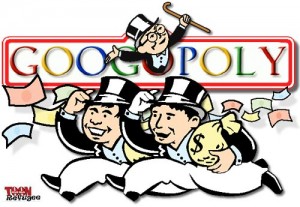
I attended a conference in early December about online privacy and Google — sponsored by ConsumerWatchdog.org — and was the victim of uncalled-for character assassination. When I dared to ask a critical question probing the validity of speakers’ assumption that Google is an unlawful Internet search monopolist, my question was met with the accusation that I am Google’s lawyer. That is simply not true.
It is a scurrilous allegation, first voiced two years ago by Microsoft, that appears intended to undermined the legitimacy of my views by ascribing them to a paying client. The reality, however, is that a simple review of court records would reveal that although Google was a former client — nearly a decade ago — since 2004 the law firms in which I was and am now a partner have been conflicted from representing Google because of litigation brought against the company. And these are not obscure cases, rather prominent ones challenging Google AdWords’ copyright policies and its age-related related employment practices. I have reiterated since 2008, when the issue was first raised, that I do not represent Google and my views on the Google-Yahoo! deal, the AdMob acquisition and the like are mine and mine alone. (See, for instance, my Oct. 2010 and April 2008 posts.) The descriptions on this site say explicitly that my clients “have over the years proudly comprised a veritable who’s who roster of the IT industry leadership,” including Google. Past tense, folks!
The tendency of Washington insiders to engage in ad hominem attacks on those voicing contrary views is reprehensible. I’ve gone the extra mile in the other direction, for instance pointing out that when Microsoft’s antitrust counsel-of-record filed massive suits against Google for small companies, “I don’t agree with guilt-by-association for lawyers in private practice.” To reiterate, neither Duane Morris LLP nor Glenn Manishin personally represent Google. Google does not pay for me to express my views. My law firms (past and present) do not count Google among their client roster. That I enjoy opining on matters of technology policy — such as net neutrality and “search neutrality” – does not mean that I am a shill for Google, Google’s allies, its partners and “ecosystem” or anyone else.
@ To reiterate, my law firm is adverse to Google, and neither I nor the firm represent the company. Thanks for your clarification!
So Gary Reback, Jeff Chester, John Simpson and others, get your facts straight. If my opinions are blather, rebut them on the merits. But do not attack the messenger because you disagree with his message. Especially when the accusation is clearly and demonstrably untrue.
P.S. In the Times, I said that Reback has a “vendetta” against Google. The Times editorialized that I was “taking a swipe” at Gary and “the claws are out.” But vendetta means a serious, long-running feud. As Reback has been going after Google for at least two years, since at least the Google book settlement, his position and public advocacy clearly qualify as a vendetta.
The news today is all about Tuesday’s “open meeting” at the FCC, where at long last a proposed regime for network neutrality will formally be considered. “There are of course a lot of moving pieces surrounding this debate, and however the chips fall, it’s going to have a long-term affect over how the Internet operates over the next several years.” The FCC Votes on Net Neutrality Tomorrow; The Internet Waits | AllThingsD.
Actually, the modest few rules FCC Chairman Genachowski has proposed are so trivial that, like all good policy, compromises or settlements, they have angered both the left and the right. The former deplores the scheme as worse than nothing, while the latter says it is a slippery slope to full regulation of the Internet.
The far more important issue tomorrow is the legal framework under which the FCC will propose net neutrality rules. After the Comcast decision in April of this year — in which a federal court of appeals threw out the Commission’s decision to sanction undisclosed throttling of P2P traffic by ISPs — net neutrality has been in a state of extreme jurisdictional chaos. For an overview, read the Fall 2010 edition of the ABA’s Icarus magazine, a symposium issue on so-called “Title II reclassification” featuring, among others, this author.
About a month ago, Genachowski also announced has was abandoning his Third Way reclassification approach. That’s a brilliant decision, as reclassification was doomed to judicial reversal and, almost certainly, an injunction or stay against implementation. The alternative is for the FCC to articulate the ancillary jurisdiction linkage or nexus between the agency’s specific areas of delegated responsibility — telephony (Title II) and broadcasting (Title III) — and its general authority over “communications by wire or radio.” Yet to do that the agency needs to distance itself from the protectionist roots and core of the ancillary jurisdiction doctrine, which for 40+ years has been used principally to squelch or constrain new technologies in order to prevent market competition with older, established industries (constituencies).
Here’s what I wrote earlier:
Ancillary jurisdiction under Southwestern Cable represents the low-water mark of communications jurisprudence. It was fashioned as a legal matter to permit FCC control of CATV, the infant predecessor to today’s robust cable programming industry, as a means of protecting the Commission’s power to regulate broadcast television. . . . It was protectionism to the core [and] epitomizes the conservative critique of administrative agencies as regulatory capture.
There is no longer an appetite in Congress to utilize governmental regulation to protect incumbents and vested commercial interests against competition and new entry. Hence, because it lacked and still lacks the political will to justify net neutrality on the ground of protecting its Title II and III jurisdiction over telephony and broadcasting — by sheltering the legacy providers of those services against disintermediation — the agency can never provide the requisite “nexus” demanded by the Comcast opinion.
Since no current policy or political figure today can admit to using regulation to handicap new entrants and favor established business interests, ancillary jurisdiction will remain the dark, dirty secret of administrative law until it is moved to a new footing. Imagine if the FCC reasoned that with IP convergence, services that formerly were within its Communications Act authority, like telephony and television, are increasingly moving to an Internet-based delivery system that, if it continues, will eventually leave all of communications beyond the FCC’s jurisdiction. Under this approach, the Commission could demonstrate a clear nexus between its statutorily delegated responsibilities and the ancillary role it proposes for net neutrality, without reverting to the sullied, protectionist past of ancillary jurisdiction.
Some observers may argue that such a “Title I” approach to net neutrality does not in principle prevent the FCC from exercising unlimited power over Internet communications. That’s overstated in my view. First, the Supreme Court’s 1970s decisions on ancillary jurisdiction (Midwest Video) hold that ancillary jurisdiction us not “unbounded.” Second, from a legislative perspective it is obvious that an administrative agency acting on the basis essentially of implied power cannot do anything broader under a general “public interest” standard than it could if acting under the express jurisdiction delegated by Congress. Specifically, while Title II authorizes full, rate-of-return common carrier regulation, the FCC would overstep its bounds imposing parallel rules under Title I ancillary jurisdiction. Third, the extreme critique from conservatives that agencies cannot be permitted to do anything without express congressional authorization really doesn’t apply; Congress has granted Title I authority over all interstate communications, it just has not fleshed that out with detailed standards.
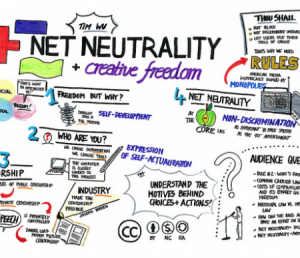
More problematic are current reports that the FCC is considering relying on Section 706 of the Act, which urges the agency to promote “advanced telecommunications” services, as its ancillary jurisdiction hook for net neutrality. That’s inane, because the Commission in the 1990s ruled over and over again that 706 was not a basis for regulatory power. This means that using 706 as the nexus for ancillary jurisdiction will necessarily stoke a hotter fight over the FCC’s reversal of its statutory interpretation, a double whammy.
The better linkage is to the basic legislative commands (e.g., Section 201) that direct the FCC to ensure just and reasonable communications and broadcasting services for users. It cannot be disputed that if current trends continue, VoIP and Internet video could and well may eventually displace POTS and cable/broadcasting, in which case there would be nothing left with which the FCC could fulfill these elementary responsibilities if such IP-based services, which do not represent “telecommunications,” “cablecasting” or “broadcasting” in traditional statutory terms, must remain forever and completely unregulated.
A broader and more cogent question is, if the FCC takes this approach, would that not create a system in which an agency decides for itself how far to go when Congress fails to update its underlying statutory power to reflect technological change? Yes, it would. But it would not be Genachowski or the FCC creating this paradigm, it was the Supreme Court. A better legal system would have an administrative agency go back to Congress and ask for new powers if its old ones are being end-run by technology. As a practical matter, that could lead to gridlock, however, as in the communications arena general revisions of the Communications Act of 1934 happen very rarely — once in 65 years, far less than every generation.
So if politics is the art of the possible, it is possible for the FCC this Tuesday to make history, survive a judicial challenge and move archaic regulatory jurisprudence forward into a new era, stripped of its protectionist past. It’s also possible the Commission will be split politically, that left-wing proponents can convince some members that a principled loss is better than a compromise win, see Net Neutrality Supporters Question FCC’s Genachowski Plan | Techworld.com, or that as it has so many times in the past, the agency will fail to explain itself in simple terms the courts demand and can understand.
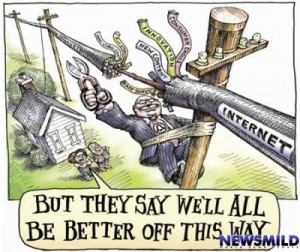
The Third Way of Title II reclassification was too cute for its own good. The Commission has a chance to correct that overreaching, but its internal bureaucratic tendencies to ambiguity and a “Chinese menu” theme for jurisdiction threaten to blow up net neutrality again. GOP Opposition to FCC Net Neutrality Plan Mounts | enterprisenetworkingplanet.com. Far more principled, regardless of one’s position on the substantive merits and policy need for network neutrality, would be for the FCC to pick a single, simple nexus. It’s not cute, it’s not expansive, but it would work. The question is whether in this highly polarized legal and political environment, the players really want anything to work at all.
Politics is always, in part, theater and sausage-making. That the law and public policy are the byproducts of such superficial pursuits remains a frustration, but in the United States it’s one we all have to live with, and one some pundits are convinced preserves the republican tradition of limited government. I for one hope the FCC keeps a more modest agenda tomorrow and moves the net neutrality debate closer to a conclusion, instead of adding fuel to the legal and policy fires that have raged on this issue for years.
|
|
 More than 15 years ago, this writer worked for one of his corporate clients on a legislative amendment offered by Rep. Anna Eshoo (D-Cal.) to the Telecommunications Act of 1996. The so-called “Eshoo Amendment,” designed to limit the role of the Federal Communications Commission in mandating standards for emerging, competitive digital technologies like home automation, passed. The irony, of course, is that at the time Congresswoman Eshoo analogized home automation to a future world like that of The Jetsons. Now 16 years down the road, we are barely closer to George, Elroy and their flying cars, robotic maids and the like than we were then.
More than 15 years ago, this writer worked for one of his corporate clients on a legislative amendment offered by Rep. Anna Eshoo (D-Cal.) to the Telecommunications Act of 1996. The so-called “Eshoo Amendment,” designed to limit the role of the Federal Communications Commission in mandating standards for emerging, competitive digital technologies like home automation, passed. The irony, of course, is that at the time Congresswoman Eshoo analogized home automation to a future world like that of The Jetsons. Now 16 years down the road, we are barely closer to George, Elroy and their flying cars, robotic maids and the like than we were then.















